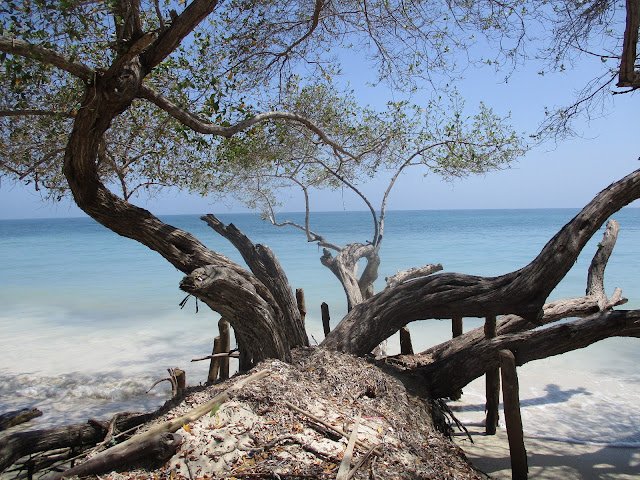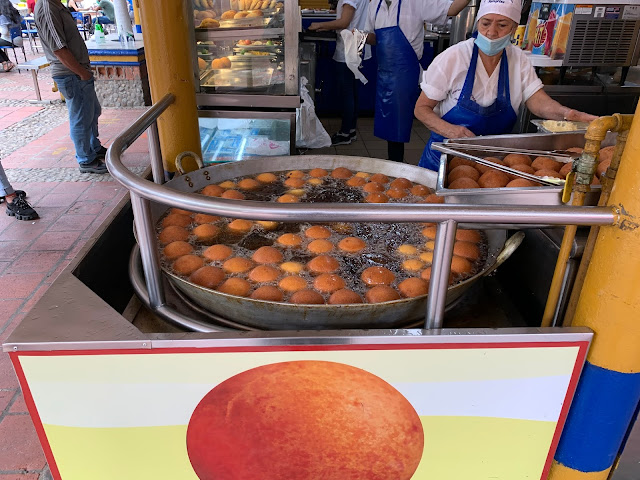 |
| Decided to check out the view on the southern boundary of the Caribbean from the Crespo neighborhood in Cartagena Colombia. |
A "visa run" is the term nomads use for the process of leaving one country and going to another in order to reset/ renew a wanderer's visa for the original country. It is really a matter of going to another country, for even a day, and getting the necessary exit and re-entry immigration stamps. In smaller countries, travelers might just catch the bus between say Thailand and Cambodia and return that afternoon. Others take the usually offered three month visa and explore the "run to" country before returning to home base.
After six months in Mexico it was time for us to make a visa run. As far as tourist visas go, Mexico is very generous in that they grant a six month tourist visa on arrival with no questions asked. On the other hand, a place like Thailand offers just a month, which you can renew for an additional two months, if you are willing to jump through a couple of hoops down at ye ole Immigration Office. A place like China or Bhutan? Mountains of paperwork for a government approved, tour guide escorted, an extortionate visa fee, all for a short stay. One does not just wander around those countries.
We had heard good things about Cartagena and we had never been to South America. So here we are.
(On a side note, this South American jaunt marks my visit to number six of the seven continents. May never get to the seventh, Antarctica, although I did apply for a cook's position at an Antarctic sub-station while working in Australia in my twenties. Alas, the employer reviewed the lengthy application and decided that I was "psychologically unsuitable" for the long and dark winters. The Peace Corps had used the same term to rebuff me a few years before that, so probably just as well.)
The history of Cartagena is grim. Spain's Pedro de Heredia landed in Cartagena in 1533 and made short work of what was left of the indigenous Calamari tribe, who had lived in the area since ~4000 BC (not that the various Caribe tribes were sitting around eating nuts and berries. De Heredia reported that he found these island settlements "largely surrounded with the heads of dead men placed on stakes").
He then established Cartagena as the the major port for trade between Spain and its overseas empire. The Spanish Empire undertook its usual rape, pillage and plunder of just about everything.... everywhere, in what was then known as New Grenada. Soon de Heredia began to import African slaves to "clear brush".
There was also plenty of gold up in 'dem thar hills. In 1533 de Heredia returned from an exploratory trip into the interior with many gold pieces, including an 132 pound solid gold porcupine.
I'll bet that porcupine got ole Queen Joanna de Castile, twiddling her insolvent thumbs back in Spain, licking her chops.
The New World slave market flourished, the gold rolled in from upcountry, the silver plundered from Peru showed up and a certain class of people prospered in Cartegena. These aristocrats became the richest in the colony and erected noble houses, great estates and libraries.
The good times, steady progress and untold riches came to an abrupt end in 1808 with the general crises of the Spanish Empire and its attending consequences. Cartagena's decline had begun.
The next several hundred years brought constant war between European powers vying for dominance. Even though Simon Bolivar succeeded in kicking out the Spanish in 1819, he was not able to unify the people of New Grenada and constant civil war persevered. To this day guerrilla armies duke it out in the various "revolutions"up in the mountains.
Because of its wealth, Cartagena was a target of not only the various European navies, but all manner of pirates, buccaneers, marauders, scalawags, rouges, scoundrels, reprobates and motley miscreants. With this history of constant war, the Spanish Inquisition, the cholera epidemics, modern day pirates like Pablo Escobar, modern day epidemics like Covid 19, today a large portion of the population of Cartagena find themselves in intractable poverty.
Having said that, the people here are certainly nice enough so one can forgive them for not bubbling over with optimism.
The upside of all these corsairs, knaves and villains trying to steal from Spain what Spain had stolen from the Amerindians is that they developed, over several hundred years, a series of impregnable defensive forts. This now picturesque walled city is the heart of the tourist experience, which includes nice plazas and the Inquisition Museum's display of ghastly torture devices, gallows, drowning chairs and a guillotine that were used to judge the faith of the population. However as the vendors are relentless, it gets kinda of old after about five times.
A short walk from the walled city is the Getsemani neighborhood. After Cartagena's emancipation from Spain in 1821, Getsemani became the neighborhood of freed slaves, craftsmen and merchants. Locals still outnumber tourists. At some point, probably associated with the general decline of Cartagena, Getsemani became a den of iniquity, offering drugs, prostitution and murder most foul. As usual, backpackers in the 1990's led the way to rebirth. The original budget hostels now rub shoulders with tapas bars, boutique hotels and a lively street art scene. Bohemian Getsemani is now known as the hippest barrio in 'da hood for the in the know traveler.We live in the quiet Crespo neighborhood, which is popular with families, vacationers from the Colombian interior and the business travelers that stay in the small boutique hotels that dot the neighborhood. Our apartment overlooks Marbella Beach and it is about a 10 minute walk away.
These city beaches, well, ain't no Cancun.
A large continental shelf extends quite far from Cartagena out into the Carribean. (The Spanish liked this geographic feature because it created a lagoon that kept the enemy's naval cannons somewhat out of range and made it difficult for the invaders to land troops. There is the entrance to the port through the channel of Tierrabomba where the Spanish built several forts that produced withering crossfire. Difficult, but not impossible for the invaders, as Cartagena was sacked and burned many times).
This shelf makes today's city beaches very shallow and a volcanic sand makes the water murky. The beach sand has many pieces of plastic and concrete....so again, it ain't no Cancun.
We rented a boat with some folks that Lilly met on an ex-pat Facebook page. The Islas de Rosario are an archipelago approximately 100 kilometres away by fast boat from Cartagena. These are Colombia's Instagram islands, which number in the hundreds. Of course, this depends on what your definition of an island is. Some of these *islands* are nothing more than a bunch of half submerged mangrove shrubs in an area the size of a school bus. The whole day was about 8 hours in duration.Our drivers would stop anywhere we wanted.Now we are getting somewhere as far as water quality is concerned. Here we stopped to swim over the wreckage of one of Pablo Escobar's wrecked planes and evidently the dude wrecked a lot of planes.Of course, everywhere we stopped, vendors paddled out with all manner of tropical treats.This gentleman, off the island of Baru, offered fresh oysters and cooked lobsters with fresh lime. Some of our crew chowed down with no unwanted side effects. It was early in the day and I abstained due to the fear of an explosive diarrhea episode in case they didn't settle in just right.One of Pablo Escobar's many summer homes. Although Escobar was killed in 1993, the Colombian government still cannot figure out who now owns the retreat and thus it has fallen into disrepair. Here we passed by Cholon Island early in the morning and it was basically empty. We stopped in on our way home later that afternoon and there were all manner of yachts and watercraft full of dozens, hundreds, of drunken revelers blasting cumbia, hip hop and salsa....generally carrying on.Alas I digress.
As awesome as the beaches were, this trip was 100 kilometres each way, not counting island cruising and the sun was brutal. It was extremely rough heading across open sea back to port that afternoon. Don't want to be a wimp about it, but not a beach trip we could do every day.
We found the food in Cartgena kinda of meh. A typical street stall will offer lots of lots of fried things like empanadas and patacones, which are a fried mashed plantain patty....bland and starchy, but cheap and filling. Above are fresh bunelos, fried cheese dough balls. There is a sweet one, like a doughnut, that is served with hot chocolate. They have a whole fried small fish that you see frequently. Fine if you like picking lots of small bones out of your teeth....sort of like fried Spot or Croaker on the East Coast After a week or so we ventured further and further away from the walled city and things get real Colombia fast. Here is the front of the gritty Bazurto Market, a giant labyrinth of warrens selling wholesale meat and vegetables for almost nothing. Its mucky, polluted and exudes danger. In a competition for squalor, Barzuto easily could compete with any similar market in India.
There is a saying here "no des papaya", which is to say "don't offer papaya" as in offering low hanging fruit, like flashy jewelry and holding up your iphone while following Google maps. A couple of rascals on a scooter may come by and leave you with considerably less possessions. A word to the wise is sufficient for us and as such we didn't take any pictures inside the market.
Cartagena really doesn't do many vegetables but instead offers a stunning array of jungle fruits, some that look like threatening animals and they cost next to nothing. This is fine if you like sucking sweet pulp off large seeds and pods. Definitely not my joy, so Lilly scrapes and squeezes these exotic beasts and makes delicious smoothies.Here is the waterfront lagoon outside Bazurto. These pelicans waited graciously until a gentleman finished his very conspicuous number two and continued chowing down on a pile of ground beef.
So after a month on the beach, we are preparing for a 13 hour bus ride south to the interior of Colombia, to see what's up in the the central Andes mountains. Specifically Medellin, which is closer to the equator, but its elevation of 4900 feet apparently offers eternal spring.

























Comments